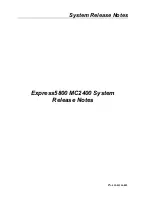
3PAR OS automatically reclaims unused snapshot space from TPVVs and fully provisioned virtual
volumes and returns the space to the LDs.
For greater administrative flexibility, you can provision the virtual volume’s user space and snapshot
space from the same or different CPGs. If the virtual volume’s user space and snapshot space are
on different CPGs, the user space remains available to the host if the CPG containing the snapshot
space becomes full. To save time by not repeating tasks, you can create many identical virtual
volumes at one time. For planning information about virtual volumes and copies of volumes, see
the HP 3PAR StoreServ Storage Concepts Guide.
Fully Provisioned Virtual Volumes
A fully provisioned virtual volume is a volume that uses LDs that belong to an LD pool known as a
CPG. Fully provisioned virtual volumes are the default system volume and do not require any
additional licenses. Unlike TPVVs, fully provisioned virtual volumes have a set amount of user space
allocated in the system for user data. They require the system to reserve the entire amount of space
required by the fully provisioned virtual volume, whether or not the space is actually used. The fully
provisioned virtual volume size is fixed, and the size limit is 16 TB. You can set snapshot space
allocation limits and usage warnings to help manage the growth of snapshot space. For detailed
information about fully provisioned virtual volumes, see the HP 3PAR StoreServ Storage Concepts
Guide.
NOTE:
Some fully provisioned virtual volumes may be designated as a
CPVV
in the HP 3PAR
CLI.
Thinly Provisioned Virtual Volumes
With an HP 3PAR Thin Provisioning Software license, you can also create TPVVs. A TPVV uses LDs
that belong to an LD pool known as a CPG. TPVVs associated with the same CPG draw user space
from that pool as needed, allocating space on demand in small increments, beginning with 256
MB per controller node. As the volumes that draw space from the CPG require additional storage,
the system automatically creates additional LDs and adds them to the pool until the CPG reaches
the user-defined growth limit that restricts the CPG’s maximum size. The TPVV volume size limit is
16 TB. For detailed information about TPVV growth warnings and growth limits, see the HP 3PAR
StoreServ Storage Concepts Guide.
Virtual Volume CLI Commands
Use the following CLI commands to manage FPVVs and TPVVs :
•
showvv
—display virtual volumes in the system.
•
createvv
—create virtual volumes.
•
setvv
—modify existing volumes.
•
growvv
—increase the size of existing virtual volumes.
•
freespace
—free snapshot space from a virtual volume.
•
removevv
—remove virtual volumes from the system.
•
showvvset
—show information about a virtual volume set.
•
createvvset
—create a virtual volume set, or add virtual volumes to an existing set.
•
setvvset
—modify a virtual volume set.
•
removevvset
—remove a virtual volume set, or virtual volumes from an existing set.
•
checkvv
—validate and repair virtual volumes.
82
Managing CPGs and Virtual Volumes
















































